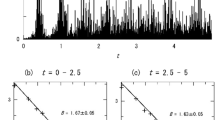Abstract
—We investigate the internal dynamics of two cellular automaton models with heterogeneous strength fields and differing nearest neighbour laws. One model is a crack-like automaton, transferring all stress from a rupture zone to the surroundings. The other automaton is a partial stress drop automaton, transferring only a fraction of the stress within a rupture zone to the surroundings. To study evolution of stress, the mean spectral density \(\cal S\)(k r ) of a stress deficit field is examined prior to, and immediately following ruptures in both models. Both models display a power-law relationship between \(\cal S\)(k r ) and spatial wavenumber (k r ) of the form \({\cal S}(k_r) \sim k^{- \beta}_r \). In the crack model, the evolution of stress deficit is consistent with cyclic approach to, and retreat from a critical state in which large events occur. The approach to criticality is driven by tectonic loading. Short-range stress transfer in the model does not affect the approach to criticality of broad regions in the model. The evolution of stress deficit in the partial stress drop model is consistent with small fluctuations about a mean state of high stress, behaviour indicative of a self-organised critical system. Despite statistics similar to natural earthquakes these simplified models lack a physical basis. Physically motivated models of earthquakes also display dynamical complexity similar to that of a critical point system. Studies of dynamical complexity in physical models of earthquakes may lead to advancement towards a physical theory for earthquakes.
Similar content being viewed by others
Author information
Authors and Affiliations
Additional information
Received October 3, 1999; revised April 5, 2000; accepted April 7, 2000
Rights and permissions
About this article
Cite this article
Weatherley, D., Jaumé, S. & Mora, P. Evolution of Stress Deficit and Changing Rates of Seismicity in Cellular Automaton Models of Earthquake Faults. Pure appl. geophys. 157, 2183–2207 (2000). https://doi.org/10.1007/PL00001080
Issue Date:
DOI: https://doi.org/10.1007/PL00001080




